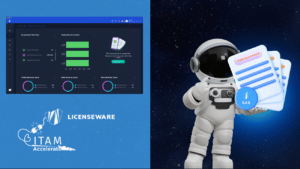Lessons from US Government Oversight: How Effective Software License Management Protects Your IT Budget

Software licenses represent a significant investment for organizations of all sizes. Yet, as a recent congressional oversight hearing on the Department of Veterans Affairs (VA) revealed, even government agencies spending over $1 billion annually on software can struggle with fundamental license management [ 🔗 Read press release here ]. For IT managers, CIOs, and procurement specialists, this case study offers a sobering reminder: poor software license management doesn’t just waste money, it can directly impact your organization’s core mission.
The VA’s challenges highlight what many private sector organizations already know: without proper systems to track, manage, and optimize software licenses, millions can disappear into a black hole of unused assets, compliance risks, and missed opportunities. But there’s good news too. By implementing robust software license management practices, organizations can transform this potential liability into a strategic advantage.
This article examines the lessons from the VA’s experience and provides actionable strategies to help your organization avoid similar pitfalls while optimizing your software investments. Whether you’re managing hundreds or thousands of licenses, these insights will help you turn license management from an administrative burden into a source of competitive advantage.
Overview of Software License Management Challenges
Software license management has evolved from a simple administrative task to a critical business function. As organizations increasingly rely on software for core operations, the complexity of managing licenses has grown exponentially. Today’s IT environments typically include a mix of on-premises applications, cloud subscriptions, and hybrid deployments, each with their own licensing models and compliance requirements.
The challenges facing organizations are multifaceted. First, there’s the sheer volume of licenses to manage. Companies with 100-499 employees use an average of 48 SaaS applications, not counting traditional software. Second, licensing models have become increasingly complex, with vendors offering perpetual, subscription, concurrent user, named user, and feature-based options. Third, the rapid pace of digital transformation means software deployments change constantly, making it difficult to maintain accurate inventories.
For many organizations, these challenges manifest in several common problems:
- Incomplete inventories: Not knowing what software is installed across the enterprise
- Usage blindspots: Inability to track whether purchased licenses are actually being used
- Cost opacity: Difficulty explaining costs for specific products bundled in licensing agreements
- Negotiation weakness: Lack of data to leverage during vendor negotiations
- Compliance risks: Exposure to potential audits and penalties
The VA’s experience, where tens of millions of dollars worth of licenses sat with “unknown” usage, is unfortunately not unique. A 2024 industry survey found that the average organization wastes 30% of its software budget on unused or underutilized licenses. For a mid-sized enterprise, this can represent millions in recoverable spending annually.
Key Lessons from the VA Case Study
The Department of Veterans Affairs’ software license management challenges, highlighted in a recent congressional oversight hearing, offer valuable lessons for organizations of all sizes. With over $1 billion spent annually on software, the VA’s struggles illustrate how even well-funded organizations can fall short without proper license management practices.
The most striking revelation from the VA case was their inability to produce a complete inventory of software licenses. Despite significant investments in technology, they couldn’t accurately track whether purchased licenses were being used or explain costs for specific products bundled in licensing agreements. This lack of visibility resulted in tens of millions of dollars worth of licenses with “unknown” usage and quantities.
For private sector organizations, the key takeaway is clear: without proper tracking mechanisms, substantial portions of your software budget may be wasted on unused or underutilized licenses. More concerning is what the VA’s Chief Information Officer acknowledged during the hearing—every unused or duplicative license represents a missed opportunity to direct those resources toward the organization’s core mission.
Another critical lesson comes from the VA’s missed deadline for producing a full inventory of all software licenses. This highlights how license management isn’t a one-time project but requires ongoing commitment and resources. Organizations that treat license management as a periodic audit rather than a continuous process often find themselves scrambling to gather information when it’s most needed, during vendor negotiations, budgeting cycles, or actual software audits.
The VA case also demonstrates how poor license management creates negotiation disadvantages. Without accurate data on current usage, organizations cannot effectively negotiate with vendors or make informed decisions about renewals, upgrades, or consolidations. This negotiation weakness often results in unfavorable terms and unnecessary spending.
Perhaps most importantly, the VA situation shows how license management issues directly impact organizational effectiveness. For the VA, inefficient software spending potentially affects veteran services. In the private sector, similar inefficiencies can reduce competitiveness, delay innovation initiatives, and erode profitability.
Best Practices for Effective License Management
Implementing effective software license management requires a strategic approach that balances compliance, cost optimization, and operational efficiency. Based on industry best practices and lessons from organizations that have successfully transformed their license management, here are key strategies to consider:
Develop a Hybrid Licensing Strategy
Modern organizations typically operate with a mix of on-premises applications, cloud services, and subscription-based software. Effective license management starts with a deliberate strategy that determines the optimal mix for your specific needs. This means:
- Assessing which deployment models (on-premises, cloud, hybrid) best suit different workloads
- Evaluating the total cost of ownership for perpetual versus subscription licenses
- Understanding how virtualization and containerization affect licensing requirements
- Identifying opportunities for license mobility between environments
A global financial services company implemented this approach and discovered that moving certain workloads to subscription models while maintaining perpetual licenses for stable, core applications reduced their overall licensing costs by 18%.
Track License Usage at a Granular Level
Generic license counts provide limited value. True optimization requires understanding exactly how software is being used throughout your organization:
- Implement tools that track feature-level usage, not just application access
- Monitor usage patterns by department, role, and individual user
- Identify peak usage periods to optimize concurrent license pools
- Establish thresholds for reclaiming inactive licenses
A manufacturing firm applied granular tracking and found that 40% of their CAD software users only needed basic functionality, allowing them to downgrade expensive premium licenses and save over $200,000 annually.
Automate Inventory and Compliance Monitoring
Manual tracking is error-prone and resource-intensive. Automation is essential for accurate, real-time license management:
- Deploy discovery tools that automatically identify all installed software
- Implement continuous monitoring for unauthorized installations
- Create automated alerts for compliance risks and upcoming renewals
- Integrate license management with procurement and HR systems
A healthcare organization implemented automated compliance monitoring and avoided $1.5 million in potential penalties by identifying and addressing licensing gaps before their annual vendor audit.
Centralize License Management
Fragmented license management across departments creates blind spots and inefficiencies:
- Establish a single repository for all license agreements and documentation
- Implement role-based access for different stakeholders
- Create standardized processes for requesting, approving, and deploying software
- Develop consistent metrics for evaluating license utilization and ROI
A retail chain consolidated 120+ separate software agreements into a centralized management system, reducing administrative overhead by 40% and improving visibility across the organization.
Implementation Strategies for Organizations
Transforming your approach to software license management requires more than just understanding best practices, it demands practical implementation strategies. Here’s how organizations can move from theory to practice:
Start with a Comprehensive Baseline Assessment
Before implementing new processes or tools, establish a clear picture of your current state:
- Conduct a complete inventory of all software assets across the organization
- Document all licensing agreements, terms, and renewal dates
- Identify high-risk and high-cost licenses that require immediate attention
- Assess current usage patterns to identify obvious optimization opportunities
An insurance company began their license optimization journey with this approach and immediately identified $800,000 in unused licenses that could be reclaimed or renegotiated.
Implement in Phases with Quick Wins First
Rather than attempting a complete overhaul, prioritize initiatives that deliver immediate value:
- Begin with the most expensive or widely used applications
- Focus initially on reclaiming obviously unused licenses
- Implement automated renewal alerts to prevent unexpected expirations
- Address compliance gaps for applications with the highest audit risk
A technology firm took this phased approach, starting with their top five software vendors that represented 60% of their software spend. Within three months, they achieved a 15% cost reduction that funded the rest of their license management initiative.
Select the Right Tools for Your Environment
The market offers numerous software license management solutions, but the right choice depends on your specific needs:
- For smaller organizations, focus on tools with low administrative overhead
- Enterprises should prioritize solutions with robust API integration capabilities
- Consider tools that integrate with existing IT asset management systems
- Evaluate reporting capabilities against the specific metrics your organization needs
A professional services firm selected a right-sized solution that integrated with their existing IT service management platform, reducing implementation time by 40% and improving user adoption.
Build Cross-Functional Collaboration
Effective license management isn’t just an IT responsibility, it requires collaboration across departments:
- Establish clear roles and responsibilities between IT, procurement, and finance
- Create standardized processes for software requests and approvals
- Implement chargeback mechanisms to increase departmental accountability
- Develop executive dashboards that demonstrate the business value of license optimization
A manufacturing company formed a software governance committee with representatives from IT, finance, and key business units, resulting in improved compliance and a 22% reduction in unnecessary license purchases.
The VA’s software license management challenges serve as a powerful reminder that even organizations with billion-dollar IT budgets can struggle with fundamental license management. For private sector organizations, the message is clear: proactive license management isn’t just an administrative function, it’s a strategic imperative with direct impact on your bottom line and operational effectiveness.
The cost of inaction is substantial. Organizations without proper license management typically waste 20-30% of their software budget on unused or underutilized licenses. Beyond the immediate financial impact, poor license management creates compliance risks, weakens negotiating positions, and diverts resources from innovation and core business objectives.
Fortunately, the path forward is clear. By implementing comprehensive inventory tracking, usage monitoring, and optimization strategies, organizations can transform license management from a liability into a strategic advantage. The private sector examples highlighted throughout this article demonstrate that effective license management isn’t just about cost reduction, it’s about creating the financial and operational flexibility to better serve your core mission.
As software continues to grow as a percentage of IT spending, the organizations that implement robust license management practices will gain a significant competitive advantage. They’ll not only avoid the pitfalls experienced by the VA but will also position themselves to make more strategic technology investments aligned with their business objectives.
The question isn’t whether your organization can afford to implement proper software license management, it’s whether you can afford not to.










